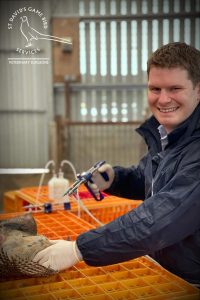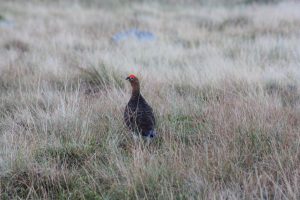Few people really know what the life of a country vet actually looks like. From going out on site, visiting clients and pioneering forward-thinking research, no day is the same.
We go behind the scenes with gamebird vet Dr Matthew Balfour, from St David’s Game Bird Services in Scotland, who takes us through a week on the job.
Matthew says:
St David’s work nationwide, but I myself am based in the Scottish practice in Edinburgh.
In a week, I will often travel across a large proportion of the Scottish countryside to visit our clients, from the central belt and Ayrshire, up to the North East coast and further north to Inverness-shire.
The terrain changes around every corner which certainly keeps us vets on our toes.
This variation, alongside going out on site, working closely with game farmers to help them produce good healthy birds and maintain good welfare standards is a huge part of why I enjoy my work so much.
This week in particular the grouse season is well underway.
We’ve had numerous submissions of samples for total worm count (TWC) and worm egg count (WEC) from grouse across the business in Scotland.
In addition we’ve had plenty of blood samples come through for louping ill antibody testing.
TWC and WEC samples are processed in our in-house laboratory, from where we are able to establish the average worm burden on the moor and make recommendations for the correct and relevant treatment regimes.
We are seeing varying levels of success in terms of bird health and numbers.
As with last year, some grouse moors are getting relatively good counts and other moors are quite poor.
There is naturally some regional variation but so far there has been no major disease outbreak this season which is a real positive.
 There have been grouse testing positive for Avian Influenza (AI) in at least one location.
There have been grouse testing positive for Avian Influenza (AI) in at least one location.
However we have been made aware of no widespread outbreaks on moors.
As wild birds, grouse don’t come under the same control legislation that applies to poultry and are tested under a separate monitoring programme with no specific area restrictions in the event of a positive result.
There may well be some more AI cases recorded in grouse this season but due to the behaviour and habitat of this species, the chance of a large-scale outbreak (as we have seen in some other wild populations) is relatively small.
We did have a difficult end to the rearing season, particularly for pheasants, which can largely be attributed to the unseasonal weather we had.

This led to sodden rearing fields and release pens with subsequent outbreaks of hexamita.
Otherwise, at this time of year, with the season in full swing, us vets have a little bit more free time.
We use this to plan ahead, carry out veterinary health plans on site, audit biosecurity, and have important discussions about the newest research and forward-thinking approaches within the business and the wider industry that we can pass on to gamekeepers.
Every farm or shoot is different; in size, location, and outlook, and we really take this into account.
In my opinion, no matter which site we are on, a healthy bird is a happy bird, and if you have good healthy birds, our shoots and farmers have businesses that are going to be successful.
Read more on Scottish Field’s News pages.
Plus, don’t miss the November issue of Scottish Field magazine.
TAGS

